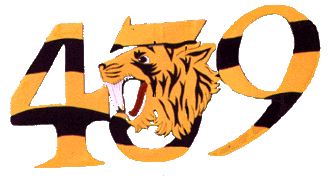|
History
of
 Squadron Squadron
  
Chapter
VII
The Advance to the Rhine
February
- March 1945
There had been the usual flak on all these operations but, with the exception of one hit on Staff Marlatt's aircraft and some interference from over zealous Mustangs, nothing untoward occurred until the day's last sortie. Cloud had forced Carr's section to spend so much time looking for an opening that fuel was running low
when the pilots finally finished their job of bombing and strafing and turned for home. They had crossed the Rhine when F/L Vic Le Gear's engine suddenly began cutting. Vic tried to make
Volkel, the nearest base, but it was too far away. He was down to 500 feet with his motor almost entirely dead when he noticed a new landing
strip at Mill and promptly set down upon it. No sooner were the wheels on the runway than the engine quit completely. A quick check showed one flak hole in the
port wing, a bad glycol leak, and a radiator filter knocked out of position. Le Gear was flown to Volkel by an Auster, where he joined Bill Breck who had landed there short of fuel.
|
Intentionally
left blank
|
Intentionally
left blank
|
The 7th was another off day, marred by a low overcast, stiff breeze and cold drizzle that developed into a steady down pour. The Chief of the Air Staff, A/M
R. Leckie, visited Eindhoven, spoke to the members of the wing and answered their questions on repatriation. Buzzbombs were still flying across the airfield with rather
disturbing frequency and occasionally made the buildings shake and windows rattle.
Listening to the pop pop and waiting for the warning silence, Bud Propas came up with the gag:
"What did one
buzz bomb say to the other?" Let' s cut! " On the night of the 7th waves of bombers passed over B.78 and the next morning, when the Canadians opened their drive into the
Reichswald. Eindhoven was "a hive of
activity". Once again the air over the targets seemed to be filled with aircraft;
"it was a treat for sore eyes."
|
|
S/L Beatty's pilots did six jobs for a total of 32 sorties, and tallied at least three (possibly four) rail cuts, four damaged locomotives, and
20 damaged freight and passenger cars. On the first operation, an armed weather recce led by Johnny Carr, the pilots passed near the Reichswald forest where they could see the tremendous barrage laid down by the artillery. Across the Rhine, at Haldern and
Dingden, they found two trains, damaged both locomotives and thoroughly strafed ten passenger coaches.
Thirty minutes later F/L Lyal Shaver's section after blowing one, and possibly another, cut in the tracks at Dingden took a few more cracks at the already
ruined passenger train. By this time as increasing over the Rhine valley and the day's third show was unable to find a break in the overcast; the bombs were jettisoned live over enemy territory.
After a long search the fourth sortie, led by Lyal Shaver, found a large hole that disclosed a
"lovely" target for their bombs a railroad bridge spanning the Regge River at Nijverdal (Holland). Coming down in a very steep dive, the pilots just missed the bridge,
but were cheered to see their bombs explode on the east bank of the river and blow two neat cuts in the tracks. In the afternoon twelve aircraft were armed with 500 lb. cluster bombs (something new for No. 439) in anticipation of a close support show for
the Canadian Army.
  
Copyright
©1998-2016 Michael T. Melnick. All rights reserved
the
unofficial homepage of  Tiger
Squadron Tiger
Squadron
.
.
|
|